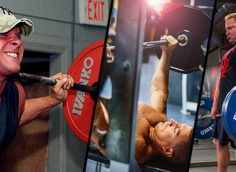Now you're ready to get under that heavy bar again. But hold up, don't ruin this for yourself. Do too much too soon and you'll be feeling new and old injuries flaring up in no time. But do it the right way and you'll build muscle and strength like a newbie.
Mindset First
Don't blow this opportunity. You may be tempted to start adding weight to the bar almost immediately. You may even try to lift exactly what you were lifting before the layoff.
But at this rate, things may start to unravel in just a couple weeks. Your shoulders will begin to feel banged up, your elbows and knees may feel the abuse, and your back will be more irritated than ever. Worst of all, you'll have barely gotten a chance to make progress.
So approach your return to the gym with more of a newbie mindset. With some intelligent programming, you'll be bigger, stronger, and more bulletproof than ever before.
Here's your return-to-action plan. Let's start with the rules...
Rule 1: Modify the Big Lifts
You're ready to lift some heavy-ass weights again, but to pave the way for those newbie gains you'll need to use some slight modifications. Here are the things you'll want to focus on:
- Slowing down your tempo: This is mainly for your most "risky" lifts. You're going to modify rep speed to help you achieve more with less weight. You'll strategically use paused reps and slow down the eccentric (lowering) portion of your big lifts. This will help you redevelop coordination and groove the pattern.
- Finding your (new) range of motion: If you haven't been deadlifting or squatting, then you'll likely have lost some of the range of motion (ROM) and joint stability in the deeper positions. So stay within your active ROM and don't try to force yourself into overly compressed positions. To recruit as much muscle as possible and avoid wear and tear, reduce the ROM in your most "risky" lifts and use pristine form.
- Using an unconventional exercise order: Textbook training advice suggests that you always start with biggest lifts first, followed by more secondary and assistance lifts. In the very short term this would result in you lifting more in your big lift since you're fresh.
Anecdotal experience would tell you, though, that in the long term this approach will only serve to beat your body up more. Long term, that means more sissy weights (since everything hurts) and inconsistent and less enjoyable workouts.
Instead, place your big lifts second in a workout for greater overall results and longevity. Strategic ordering of exercises is a smart approach for anyone who wants to preserve his or her joints and even build up lagging muscles.
Rule 2: Allow Variety Before Narrowing Down
If you want to look good naked and be generally strong, then having some variety in your workouts is important. Variety will help you feel-out your new approach, solve some potential problems (like equipment availability and your body not feeling the same as before), and add a much-needed change in stimuli to your routines.
Having a big toolbox and trying out different exercises will allow you to narrow down better long term. The longer you've been training and the more you get exposed to different training options, the better you'll understand your own body.
Remember, you're an honorary newbie right now, so you'll do well by expanding your exercise vocabulary before narrowing back down again. And don't be surprised if things don't feel the same as they did before. Embrace new exercises and be open to change.
It's not hard to see how a little freedom leads to a more enjoyable approach to training, too. This will keep you consistent and allow you to make steady gains while remaining injury-free.
Rule 3: Make Every Rep Count
If you trained with lighter weights while on break you may have a greater appreciation of creating maximal tension with minimal loads. Just because you've got the means to lift more weight now, don't drop that level of focus you've been using to maximize tension.
Focusing on each rep causes the mechanical tension, metabolic stress, and tissue breakdown that ultimately triggers a cascade of events leading to growth. Muscle growth and developing neural efficiency are prerequisites to building strength. More tension also makes your muscles work harder, which requires more energy and helps burn body fat.
If you have performance-related goals then having some external focus later down the line will come into play (load, bar speed, and more), but right now you want to maintain tension and feel every rep working its magic.

The Return-to-Action Workout Plan
It's important you understand how to use these workouts, and how to individualize them to make them work best for you.
Weekly Volume
Every week you'll do three types of workouts (push, pull, legs). That means if you train more than three days per week, at least one of those categories will get repeated.
Each of the workouts repeated twice will allow you to complete around 10-20 sets per week, per main muscle group. For example, 10 sets for your chest, 10 sets for your hamstrings and so on. (Sample schedules below.)
Weekly Frequency
Depending on how frequently you train, you'll want to complete each of the workouts below 4-6 times. That means you'll end up doing four lower-body workouts, four push workouts, and four pull workouts.
In total, you'll get 3-4 weeks of consistent workouts if you're planning on training 4-6 days each week.
Stick to the workouts below and simply alter how frequently you do them. This will allow you to individualize your program based on your ability to recover from the prescribed volume.
Along with the flexibility, you'll have with some exercises choices. This will help you stay consistent for long enough to see significant changes in your physique, and for lifting numbers to improve.
Since we're programming for the masses here – assuming that you're in the 70% "average recovery" group – your 5-day training split will look like the following where each workout is done 5 times over 3 weeks (days of the week and order of workouts can be changed):
Week 1
- Monday: Lower
- Tuesday: Push
- Wednesday: Pull
- Thursday: Off
- Friday: Lower
- Saturday: Push
- Sunday: Off
Week 2
- Monday: Pull
- Tuesday: Lower
- Wednesday: Push
- Thursday: Off
- Friday: Pull
- Saturday: Lower
- Sunday: Off
Week 3
- Monday: Push
- Tuesday: Pull
- Wednesday: Lower
- Thursday: Off
- Friday: Push
- Saturday: Pull
- Sunday: Off
If you're planning on 4 workouts per week then your schedule will look like this. Each workout is done 4 times over 4 weeks:
Week 1
- Monday: Lower
- Tuesday: Push
- Wednesday: Off
- Thursday: Pull
- Friday: Off
- Saturday: Lower
- Sunday: Off
Week 2
- Monday: Push
- Tuesday: Pull
- Wednesday: Off
- Thursday: Lower
- Friday: Off
- Saturday: Push
- Sunday: Off
Week 3
- Monday: Pull
- Tuesday: Lower
- Wednesday: Off
- Thursday: Push
- Friday: Off
- Saturday: Pull
- Sunday: Off
Sets and Reps
You'll notice the set and rep ranges are broad in some cases. That's because lots of protocols work for building muscle and looking good naked.
In the long run, you'll see negligible results between doing sets of 8 reps versus sets of 12. So rather than tell you to do 10 reps and get angry when you only hit 8, you're better with a range rather than an exact prescription.
Since it's been a while since you've lifted heavy(ish), you'll likely want to be hitting those lower-end hypertrophy rep ranges. So spend some time doing your big lifts with sets of 5-7 reps, but at the slower tempos (see the first rule above).
Other exercises will be in the 8-12 rep range, with the odd foray up to 15-20. In most cases, 20 reps are prescribed as a back-off set after doing heavier sets prior.
Progression
You can't predict how fast your body is going to adapt to any program, especially one you've never done before. Your progression is naturally built in over your 3-4 week training plan and auto-regulated by you. Volume and rep ranges remain the same throughout, but you'll regulate the progression in each workout depending on how you feel.
- First workout: No pressure on lifting performance. Just get your bearings and leave 2-3 reps in reserve (RIR) for most sets. Log your workout.
- Second workout (of the same type): Try to get 1-2% better than the last workout on a few exercises. That means a little more weight or an extra rep or two, providing you can maintain a solid technique. Since you left a few reps in the tank last time, this should be relatively manageable. Aim for around 1-2 RIR for most sets.
- Third workout (of the same type): Get 1-2% better (weight or reps), pushing closer to failure on most sets. Think 0-2 RIR for most sets.
- Fourth workout (of the same type): Strive to get 1-2% better again. If you're still improving on your main lifts then plan a fifth workout of the same type. If progress has stalled by this point, now's the time to change to another plan or layer in some new main exercises.
- Fifth workout and beyond (of the same type): Same rules as above. If progress has stalled, change it up.
Exercise Sequence & Selection
You're going to be starting with more of an isolation-style of lift before hitting your most "risky" main lift. After crushing your main lift, you'll follow up with a second multi-joint exercise using a higher rep range. The main and secondary lifts stay the same throughout this program.
You'll finish with two isolation lifts or an extra multi-joint lift and one isolation lift. For these exercises, you'll notice you have some flexibility. This is to offer you some variety and give you a chance to use equipment you might not have used in a while. It's a way to control the "kid in the candy store" mentality, somewhat.
If an exercise doesn't feel right, modify it until it does. If you know that it's never going to feel right, then scrap it and swap for a similar movement. Try to maintain the overall structure of these workouts, and always consider the rules described above.
The Workouts
Lower-Body Day
- Pre-Isolation: Lying Hamstring Curl – 3 sets of 8-12 reps, then a back-off set of 20 reps. Rest a minute between sets. Doing your ham curl first will make your squats feel better.
- Main Lift: Paused Squat – 5 sets of 5-7 reps. Take 4 seconds to lower and pause for a second at the bottom. Rest 2-4 minutes between sets.
Start lighter than you think you need to and abide by the tempo. Stay within your active range of motion. For some, 90 degrees would be optimal.
- Secondary: Weighted Back Extension or Cable Pull-Through – 4 sets of 8-12 reps. Take a minute or two to rest.
- Quad Isolation: Leg Extension Machine or Pike Leg Extension – Do 4 sets of 12-20 reps. Rest a minute or two between sets. Use these to load your quads in their shortened position, create an occlusion-type effect, and build a complete set of wheels.
- Core: Ab Wheel Roll-Out, Body-Saw, Hanging Leg Raise, or Decline Reverse Crunch – Pick one and do 5 sets of 12-15 reps. Rest a minute between sets. Stay within the prescribed reps and add resistance when needed.
Pull Day
- Pre-Isolation: Cable Straight-Arm Pulldown – 3 sets of 8-12 reps, then a back-off set of 20 reps. Rest a minute between sets. These will pre-fatigue your back and activate your lats before your main lift.
- Main Lift: High Trap Bar Deadlift to Shrug – 5 sets of 5-7 reps. Take 2 seconds to lower. Rest 2-4 minutes between sets.
Use the high handles and elevate the trap bar off the floor as much as needed. The start position should ideally remain below your knees for maximum transfer. This can be subbed for a barbell rack pull to shrug if necessary.
- Secondary: Weighted Chin-Up or Pulldown – 4 sets of 8-12 reps. Rest 1-2 minutes between sets. Focus on driving your elbows down into your pockets.
- Secondary: Seated Cable Row or Plate-Loaded Row Machine – 3 sets of 8-12 reps, then a back-off set of 20 reps. Rest 1-2 minutes between sets. Don't fix your shoulder blades. Allow a full range of motion.
- Bicep Isolation: Cable, Dumbbell, or Barbell Curl – Pick one variation and do 3 sets of 10-12 reps, then a back-off set of 20 reps. Rest a minute between sets.
Push Day
-
- Pre-Isolation: Cable Face Pull – Do 3 sets of 10-12 reps, then a back-off set of 20 reps. Rest a minute between sets. This will prime your upper back, rear delts, and external rotators before heavy pressing.
- Main Lift: Paused Bench Press – Do 5 sets of 5-7 reps. Take 4 seconds to lower with a 1-second pause. Rest 2-4 minutes.
- Secondary: Seated Neutral-Grip Shoulder Press – Do 4 sets of 8-12 reps. Rest 1-2 minutes between sets. This'll pack some meat on your delts using a relatively shoulder-friendly vertical press.
- Chest Isolation: Flye Variation – Do 3 sets of 8-12 reps, then a back-off set of 20 reps. Rest 1-2 minutes between sets. Cables would work well here, but you've got plenty of options.
- Triceps Isolation: Triceps Extension Variation – Do 3 sets of 10-15 reps, then a back-off set of 20 reps. Rest a minute between sets.
Already a T Nation+ Member? Log in
You haven’t completed your membership signup
Your T Nation+ membership has expired
Get instant access to this content
Become a T Nation+ member and get immediate access to all of our member-only videos, articles, coaching groups and more.
Click here to learn more about T Nation+Click here to complete the signup processClick here to renew your membership





